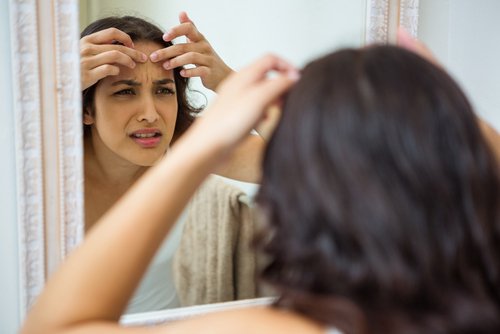Brown Patches and Changes in Skin During Pregnancy

It’s very common for brown patches to appear as well as other changes in skin during pregnancy. These spots tend to appear as dark splotches, commonly known as the “mask of pregnancy.” Technically, they’re referred to as chloasma or melasma.
As soon as a woman becomes pregnant, her body experiences changes every month. There are some alterations that can cause discomfort, so it’s important to be well prepared. Do you know what to do in the face of these dark patches that can appear on your skin?
Why do brown spots and other skin changes occur during pregnancy?
During the nine months of gestation, hormone levels increase and may even produce dark spots on the skin of some mothers.
Chloasmas, also known as melasmas or the “mask of pregnancy,” are spots that appear during pregnancy. In most cases, they appear on the face. On occasion, they can also cause itching.
However, the consequences have to do with more than just aesthetics. In fact, they can produce more emotional issues than physical ones. This is because they tend to affect a woman’s self-esteem – causing her to feel worried and ashamed of the image she gives off.
Most of the changes in skin that occur during pregnancy appear on the face, mainly on the forehead, nose and cheeks and the jaw. They can also appear on the upper lip and, in a few cases, around the eyes.
At the same time, they can appear on other parts of the body. These include forearms, armpits, the groin, the abdomen and other areas that are exposed to sunlight.
These brown colored spots show up, in most cases, during the last 6 months of pregnancy. Also, they can appear due to a genetic factor. Some women are more prone to developing these spots if they have direct family members that have presented these characteristics.

Types of chloasma
There are three types of chloasma, which depend on the depth of the melanin:
- Dermal melasma: Appears on the skin, with blurred borders, on the cheeks.
- Epidermal melasma: This condition appears in the epidermal layers. The borders are slightly more defined and are located in the center of the face. It tends to be the easiest type to treat.
- Mixed: This is a combination of the two previous types and can be the hardest to treat. It’s frequent in pregnant women, who produce the spots naturally. In pregnant women, it’s known as “chloasma gravidarum.”
“During the nine months of gestation, hormone levels increase and may even produce dark spots on the skin of some mothers.”
Is avoiding these spots on the skin possible?
There is no known means of preventing these changes in the skin. Each pregnancy is different and not all pregnant women experience these changes. In some cases, the dark spots disappear on their own once a woman has given birth.
However, in most cases, they don’t go away completely. If you have any doubts or worries about this condition, it’s important you consult a specialist.
Treating brown patches and changes in skin during pregnancy
It’s important to avoid certain treatments while pregnant. This is because they may end up causing the production of even more melanin, thus causing even more dark patches.
However, there are some viable options. But you must always be sure to check with a specialist before starting any type of treatment.
- Sunscreen: You should use sunscreen at all times to protect your skin and the spots that appear. Be sure to follow the instruction of your dermatologist.
- Reduced sun exposure: If you experience these changes in your skin during pregnancy, you should limit your exposure to the sun. This is especially true in regards to your face. Using hats, sunglasses and other types of accessories is recommended.

- Laser sessions: As mentioned above, these brown patches don’t always go away after giving birth. If that’s your case, and other forms of treatment are unsuccessful, you can try laser sessions. About 10 sessions will help to remove the pigmentation. Again, treatment should only take place under the supervision of a specialist.
- Care for your skin: You should be very strict and disciplined when it comes to taking care of your skin. You should establish a daily routine for cleansing and moisturizing your skin. Use cleansing products and lotions that are especially designed for your face.
Several months can go by before you see improvements in your skin. Therefore, it’s of vital importance that you continue to protect your skin from the sun during and after treatment.
If the brown patches persist, you should see a dermatologist to determine the cause of the changes and the right treatment.
It’s very common for brown patches to appear as well as other changes in skin during pregnancy. These spots tend to appear as dark splotches, commonly known as the “mask of pregnancy.” Technically, they’re referred to as chloasma or melasma.
As soon as a woman becomes pregnant, her body experiences changes every month. There are some alterations that can cause discomfort, so it’s important to be well prepared. Do you know what to do in the face of these dark patches that can appear on your skin?
Why do brown spots and other skin changes occur during pregnancy?
During the nine months of gestation, hormone levels increase and may even produce dark spots on the skin of some mothers.
Chloasmas, also known as melasmas or the “mask of pregnancy,” are spots that appear during pregnancy. In most cases, they appear on the face. On occasion, they can also cause itching.
However, the consequences have to do with more than just aesthetics. In fact, they can produce more emotional issues than physical ones. This is because they tend to affect a woman’s self-esteem – causing her to feel worried and ashamed of the image she gives off.
Most of the changes in skin that occur during pregnancy appear on the face, mainly on the forehead, nose and cheeks and the jaw. They can also appear on the upper lip and, in a few cases, around the eyes.
At the same time, they can appear on other parts of the body. These include forearms, armpits, the groin, the abdomen and other areas that are exposed to sunlight.
These brown colored spots show up, in most cases, during the last 6 months of pregnancy. Also, they can appear due to a genetic factor. Some women are more prone to developing these spots if they have direct family members that have presented these characteristics.

Types of chloasma
There are three types of chloasma, which depend on the depth of the melanin:
- Dermal melasma: Appears on the skin, with blurred borders, on the cheeks.
- Epidermal melasma: This condition appears in the epidermal layers. The borders are slightly more defined and are located in the center of the face. It tends to be the easiest type to treat.
- Mixed: This is a combination of the two previous types and can be the hardest to treat. It’s frequent in pregnant women, who produce the spots naturally. In pregnant women, it’s known as “chloasma gravidarum.”
“During the nine months of gestation, hormone levels increase and may even produce dark spots on the skin of some mothers.”
Is avoiding these spots on the skin possible?
There is no known means of preventing these changes in the skin. Each pregnancy is different and not all pregnant women experience these changes. In some cases, the dark spots disappear on their own once a woman has given birth.
However, in most cases, they don’t go away completely. If you have any doubts or worries about this condition, it’s important you consult a specialist.
Treating brown patches and changes in skin during pregnancy
It’s important to avoid certain treatments while pregnant. This is because they may end up causing the production of even more melanin, thus causing even more dark patches.
However, there are some viable options. But you must always be sure to check with a specialist before starting any type of treatment.
- Sunscreen: You should use sunscreen at all times to protect your skin and the spots that appear. Be sure to follow the instruction of your dermatologist.
- Reduced sun exposure: If you experience these changes in your skin during pregnancy, you should limit your exposure to the sun. This is especially true in regards to your face. Using hats, sunglasses and other types of accessories is recommended.

- Laser sessions: As mentioned above, these brown patches don’t always go away after giving birth. If that’s your case, and other forms of treatment are unsuccessful, you can try laser sessions. About 10 sessions will help to remove the pigmentation. Again, treatment should only take place under the supervision of a specialist.
- Care for your skin: You should be very strict and disciplined when it comes to taking care of your skin. You should establish a daily routine for cleansing and moisturizing your skin. Use cleansing products and lotions that are especially designed for your face.
Several months can go by before you see improvements in your skin. Therefore, it’s of vital importance that you continue to protect your skin from the sun during and after treatment.
If the brown patches persist, you should see a dermatologist to determine the cause of the changes and the right treatment.
This text is provided for informational purposes only and does not replace consultation with a professional. If in doubt, consult your specialist.








